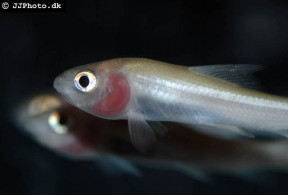Labeo boga
Violet Shark
SynonymsTop ↑
? Cyprinus falcatus Bloch, 1795; Cyprinus boga Hamilton, 1822
Etymology
Labeo: from the Latin labeo, meaning ‘one with lips’, in allusion to the remarkably thick, fleshy lips in members of this genus.
boga: presumably a vernacular Bengali name for this species.
Classification
Order: Cypriniformes Family: Cyprinidae
Distribution
This species occurs in most major river system in India (excluding the western slopes of the Western Ghats mountains), Pakistan, Nepal, Bangladesh, and Myanmar.
Type locality is ‘Brahmaputra River, India’.
Habitat
Inhabits major river channels and larger tributaries, and is also found in some man-made reservoirs and other impoundments.
Maximum Standard Length
200 – 250 mm.
Aquarium SizeTop ↑
An aquarium with base dimensions of 240 ∗ 60 cm or equivalent should be the smallest considered.
Maintenance
Choice of décor is not as critical as water quality and the amount of open swimming-space provided.
However should you possess the means to provide and decorate a sufficiently-sized aquarium for long term care this species would look superb in a set-up designed to resemble a flowing river with a substrate of variably-sized rocks and gravel, some large water-worn boulders and driftwood branches.
Water Conditions
Temperature: 18 – 24 °C
pH: 6.0 – 8.0
Hardness: 36 – 268 ppm
Diet
Primarily a benthic feeder and will accept most sinking foods, including live or frozen chironomid larvae (bloodworm), Tubifex, and proprietary dried products.
Behaviour and CompatibilityTop ↑
Can be aggressive towards conspecifics and other similarly-shaped fishes, especially in small aquaria.
NotesTop ↑
Despite its unsuitability for the majority of home aquaria, this species is available in the aquarium trade on an irregular basis, and has also been marketed as ‘violet-gilled shark’, ‘red-gilled violet shark’ and ‘blushing violet shark’.
It appears likely that L. boga as currently recognised represents a complex of closely-related species.
The genus Labeo is an enigmatic grouping containg more than 100 species which is critically in need of revision. Members occur throughout much of Africa and Asia, and they are considered members of the tribe Labeonini within the putative cyprinid subfamily Cyprininae or simply the subfamily Labeoninae (name varies with author). According to the most recent phylogenetic research, this grouping is further divided into four subtribes; Labeoina, Garraina, Osteochilina, and Semilabeoina (Yang et al., 2012). Among these, Labeo is included in the Labeoina alongside Bangana sensu stricto (which includes the genus Nukta), Cirrhinus sensu stricto, Cirrhinus microlepis (which is of a different genetic lineage to other Cirrhinus species), Gymnostomus, and Incisilabeo.
Thirty Labeo species were used in the study, and the genus was found to be polyphyletic, although all were nested within the Labeoina clade (Yang et al., 2012). Labeo boggut, L. bata and L. bata var. formed a clade with Incisilabeo behri, Schismatorhynchos nukta, and Bangana dero (the type species of the genus) and B. sp. Salween. All other Labeo species comprised a group referred to as Labeo sensu stricto which also includes Gibelion catla, and the authors recommended that the latter be synonymised with Labeo, although this does not appear to have been widely accepted (eg. Kottelat, 2013).
References
- Hamilton, F., 1822 - Edinburgh & London: i-vii + 1-405
An account of the fishes found in the river Ganges and its branches. - Kottelat, M., 2013 - Raffles Bulletin of Zoology Supplement 27: 1-663
The fishes of the inland waters of southeast Asia: a catalogue and core bibiography of the fishes known to occur in freshwaters, mangroves and estuaries. - Shrestha, T. K., 2008 - Himalayan Ecosphere, Kathmandu, Nepal: 1-389
Ichthyology of Nepal. A study of fishes of the Himalayan waters. - Stiassny, M. L. J. and A. Getahun, 2007 - Zoological Journal of the Linnean Society 150(1): 41-83
An overview of labeonin relationships and the phylogenetic placement of the Afro-Asian genus Garra Hamilton, 1922 (Teleostei: Cyprinidae), with the description of five new species of Garra from Ethiopia, and a key to all African species. - Yang, L. and R. L. Mayden, 2010 - Molecular Phylogenetics and Evolution 54(1): 254-265
Phylogenetic relationships, subdivision, and biogeography of the cyprinid tribe Labeonini (sensu Rainboth, 1991) (Teleostei: Cypriniformes), with comments on the implications of lips and associated structures in the labeonin classification. - Yang, L., M. Arunachalam, T. Sado, B. A. Levin, A. S. Golubtsov, J. Freyhof, J. P. Friel, W-J. Chen, M. V. Hirt, R. Manickam, M. K. Agnew, A. M. Simons, K. Saitoh, M. Miya, R. L. Mayden, and S. He, 2012 - Molecular Phylogenetics and Evolution 65(2): 362-379
Molecular phylogeny of the cyprinid tribe Labeonini (Teleostei: Cypriniformes).




